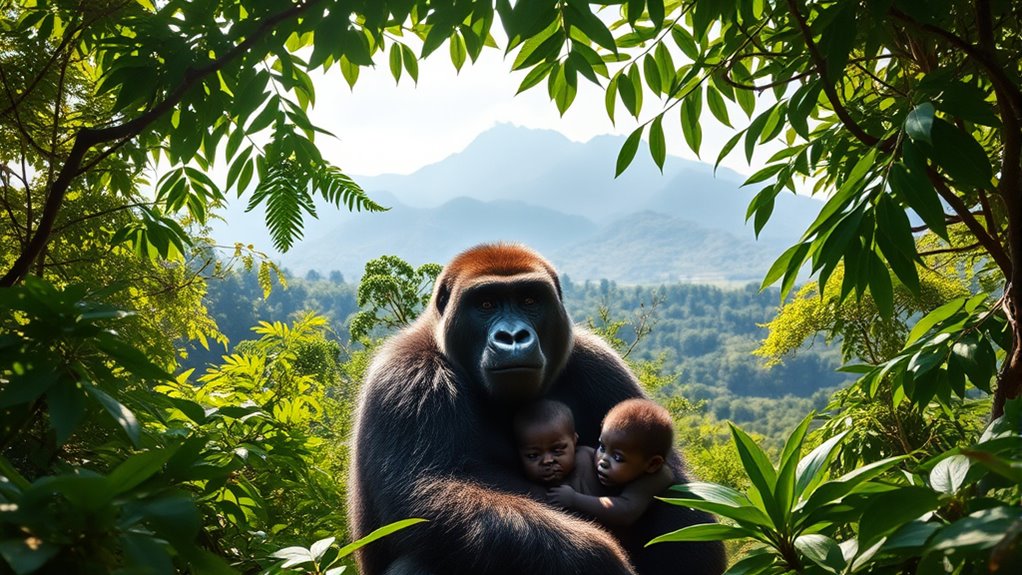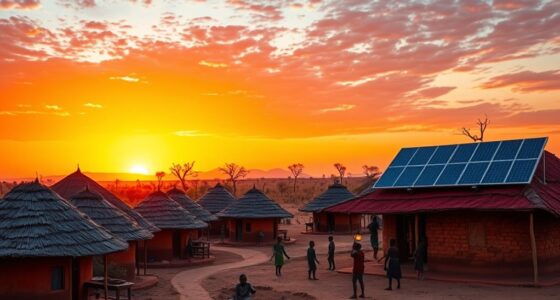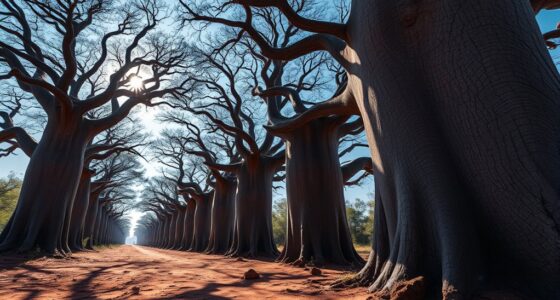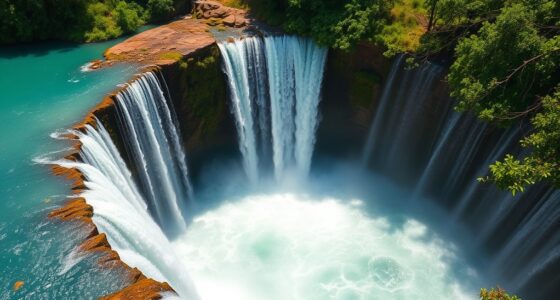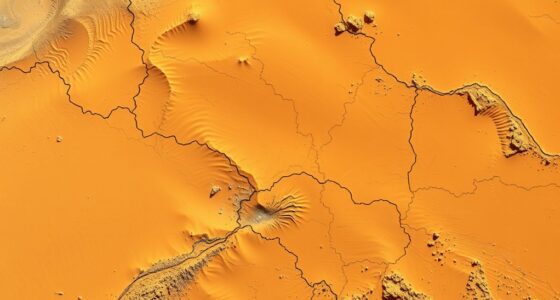Rwanda became a global leader in gorilla conservation by smartly combining eco-tourism, community involvement, and sustainable funding. You’ll see how tourism revenue supports conservation efforts while providing jobs and benefits to local communities. This approach encourages locals to protect gorillas and their habitat, creating a win-win situation. Their successful model shows how ecological preservation can go hand-in-hand with economic growth. Discover how Rwanda set this inspiring example and what makes their strategy so effective.
Key Takeaways
- Rwanda implemented innovative conservation models combining environmental protection with community involvement and sustainable eco-tourism.
- Revenue from eco-tourism funds gorilla protection, creating a self-sustaining cycle that incentivizes local support.
- Local communities participate actively in conservation, gaining employment and benefits that improve their livelihoods.
- Community-based projects focus on education, health, and sustainable agriculture, fostering ownership of conservation efforts.
- Rwanda’s integrated approach successfully balances species preservation with economic growth, establishing a global leadership model.
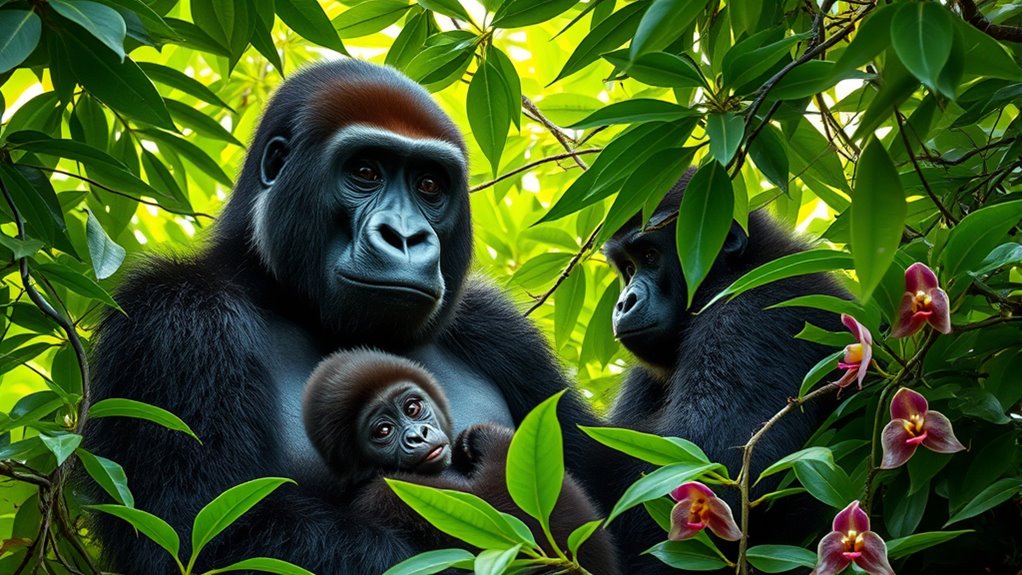
Have you ever wondered how Rwanda manages to protect its famous mountain gorillas? The answer lies in a combination of innovative conservation strategies, dedicated community involvement, and the strategic development of eco-tourism benefits. Rwanda has positioned itself as a global leader in gorilla conservation by creating a sustainable model that benefits both the environment and local communities. This approach not only helps preserve these majestic creatures but also ensures that local people see tangible benefits from conservation efforts, encouraging their active participation and support.
Eco-tourism benefits play a central role in Rwanda’s conservation success. By attracting tourists from around the world enthusiastic to see mountain gorillas in their natural habitat, Rwanda has generated substantial revenue that directly funds conservation programs. These funds are used to monitor gorilla groups, combat poaching, and maintain the parks’ ecosystems. Instead of relying solely on government funding or international aid, eco-tourism creates a self-sustaining cycle where tourism dollars fuel ongoing conservation work. This system makes the protection of gorillas economically viable, giving local communities a stake in the animals’ survival.
Eco-tourism fuels conservation by generating revenue that supports gorilla protection and local community benefits.
Community involvement is another critical pillar of Rwanda’s approach. Recognizing that local residents live alongside gorilla habitats, Rwanda’s conservation programs actively include these communities. Many locals are employed as park rangers, guides, or in other roles that support eco-tourism. They also benefit financially from tourism activities, which can be more lucrative than alternative livelihoods like farming or hunting. By involving communities in conservation efforts, Rwanda fosters a sense of ownership and responsibility for protecting gorillas. This connection encourages locals to act as guardians of the wildlife and their habitat, reducing threats such as poaching or habitat destruction.
Furthermore, community-based projects extend beyond employment. Many programs focus on education, sustainable agriculture, and health initiatives that improve local living standards. When communities see direct benefits from conservation, they become strong allies in protecting gorillas and their environment. This integrated approach creates a positive feedback loop: healthier communities are better able to support conservation efforts, which in turn ensures the survival of the gorillas and the ecosystems they inhabit. The use of eco-tourism as a sustainable funding model has been crucial to this success.
In essence, Rwanda’s success stems from viewing conservation through a holistic lens. By harnessing eco-tourism benefits and fostering community involvement, the country has built a model that balances ecological preservation with economic development. This strategy not only saves one of the world’s most endangered species but also uplifts local communities, proving that conservation and human prosperity can go hand in hand.
Frequently Asked Questions
How Does Rwanda Fund Its Gorilla Conservation Programs?
You might wonder how Rwanda funds its gorilla conservation programs. The country relies on eco-tourism revenue from visitors who come to see the mountain gorillas, generating significant income. Additionally, Rwanda secures international grants from conservation organizations and governments that support preservation efforts. These funds help maintain protected areas, support local communities, and guarantee the continued success of gorilla conservation, making Rwanda a leader in this essential effort.
What Community Benefits Are Linked to Gorilla Tourism?
Have you ever wondered how gorilla tourism transforms local communities? Eco tourism benefits include job creation, improved infrastructure, and increased income for residents. This community empowerment fosters pride and sustainability, ensuring conservation efforts thrive. By attracting tourists, you support local businesses and help protect these incredible animals. Isn’t it inspiring to see how responsible tourism can uplift communities while safeguarding gorillas for future generations?
How Does Rwanda Prevent Poaching of Mountain Gorillas?
You can see that Rwanda prevents poaching by implementing eco-friendly policies and maintaining wildlife corridors. These corridors connect gorilla habitats, reducing human-wildlife conflicts and making poaching less tempting. The government enforces strict anti-poaching laws and collaborates with local communities, encouraging conservation efforts. By promoting sustainable tourism and protecting natural areas, Rwanda actively safeguards its mountain gorillas, ensuring their survival for future generations.
What Are the Main Challenges in Gorilla Conservation?
You face challenges like habitat fragmentation, which limits gorillas’ space and resources, making their survival harder. Disease transmission also poses a serious threat, especially as close human contact can spread illnesses to these fragile animals. Addressing these issues requires ongoing efforts to protect natural habitats and implement strict health protocols, ensuring gorillas remain safe and populations thrive despite these obstacles.
How Are Gorilla Populations Monitored and Tracked?
Imagine peering through dense green foliage as you track gorillas. You use advanced tracking technology to monitor their movements and behaviors, ensuring they stay safe. By identifying individual gorillas through unique features like scars and facial markings, you keep detailed records of their populations. This careful Gorilla identification helps conservationists understand trends, prevent poaching, and protect these incredible creatures for future generations.
Conclusion
Like a shepherd tending to a treasured flock, Rwanda’s dedication has safeguarded its mountain gorillas from extinction. Your role in supporting conservation efforts guarantees these gentle giants continue to thrive, symbolizing hope and resilience. Just as a single drop creates ripples in a pond, your actions contribute to a global wave of change. Together, you and Rwanda nurture a sanctuary where nature’s most precious guardians can flourish for generations to come.

